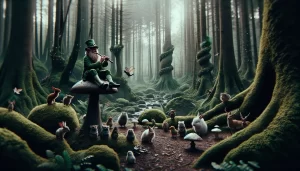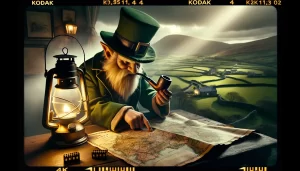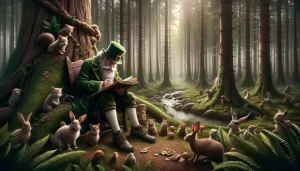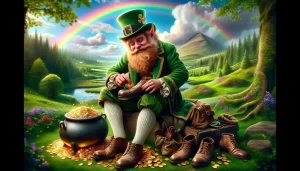Leprechaun Origins
Irish Folklore
Leprechauns are diminutive supernatural beings in Irish folklore, and probably the most well known of all the Irish folklore creatures, known for their mischievous nature and their ability to grant wishes. According to leprechaun folklore and leprechaun mythology, these little men were shoemakers who stored their gold in pots at the end of rainbows. Whoever caught a leprechaun could force him to reveal the location of his treasure, but the leprechaun could also grant a wish in exchange for his freedom.
Irish Mythology
In Irish mythology, leprechauns are often associated with the god Lugh, who was known for his skill in many areas, including craftsmanship and trickery. Lugh was a member of the Tuatha Dé Danann, a group of supernatural beings who were said to have inhabited Ireland before the arrival of the Celts.
Ulster and Lugh
In Ulster, leprechauns were believed to be the descendants of Lugh, who was said to have had a son named Luchorpán. Luchorpán was known for his ability to change his size and shape, and was often depicted as a trickster figure.
Tuatha Dé Danann
The Tuatha Dé Danann were a powerful group of supernatural beings who were said to have ruled over Ireland before the arrival of the Milesians, the ancestors of the modern Irish people. According to legend, the Tuatha Dé Danann possessed great magical powers, and were able to control the elements and shape-shift at will.
Clurichaun
The clurichaun is a type of leprechaun that is known for its love of drinking and mischief-making. Unlike the more benevolent leprechaun, the clurichaun is often depicted as a drunkard who causes trouble for humans.
Luchorpán
Luchorpán is a term that is often used interchangeably with leprechaun in Irish folklore. The word is derived from the Gaelic Irish words “lú” (small) and “corp” (body), and is often translated as “little body”.
Fergus Mac Léti
Fergus Mac Léti was a legendary king of Ulster who was said to have been transformed into a leprechaun after his death. According to legend, Fergus was a skilled warrior and a wise ruler, but was cursed by a rival king and forced to spend eternity as a leprechaun.

Leprechaun Characteristics
Physical Appearance
Leprechauns are diminutive supernatural beings in Irish folklore. They are usually depicted as little bearded men, standing only about 2-3 feet tall, with a wrinkled and aged appearance. They are often shown wearing a green coat and hat, and leather apron.
Mischievous Nature
Leprechauns are known for their mischievous nature. They are quick-witted, highly intelligent, and will do anything to evade capture. They are solitary by nature and can be a source of mischief for the unwary. The sound of their hammering betrays their presence, and they are known to play tricks on humans like hiding their belongings or leading them on wild goose chases.
Magic and Wishes
Leprechauns are said to possess magical powers. They are known to have the ability to grant three wishes to anyone who captures them. However, they are also known to be quite cunning and will try to trick humans into making wishes that will not benefit them. Leprechauns are also believed to possess a hidden crock of gold, which they guard fiercely.
Leprechaun Traditions
Shoemaking
One of the most well-known leprechaun traditions is their shoemaking skills. Leprechauns are often depicted as cobblers, and it is said that the sound of their hammering can be heard in the distance. They are known for making shoes and brogues of the highest quality, and it is said that they take great pride in their work.
Pot of Gold
Another popular tradition associated with leprechauns is their supposed pot of gold. It is said that leprechauns are the guardians of a pot of gold, which they hide at the end of a rainbow. However, catching a leprechaun and forcing him to reveal the location of his pot of gold is not an easy task. Leprechauns are known for their trickery and are skilled at outwitting those who try to capture them.
Trickery
Leprechauns are often depicted as tricksters, and this is another important aspect of their tradition. They are known for their mischievous behavior and their ability to outsmart humans who try to catch them. It is said that if you catch a leprechaun, he will grant you three wishes in exchange for his freedom. However, be warned that leprechauns are known to twist the wording of wishes to their advantage, so be careful what you wish for.
Leprechauns in Literature and Art
William Allingham
William Allingham was a 19th-century Irish poet who wrote extensively about leprechauns. In his poem “The Lepracaun Or, Fairy Shoemaker,” he describes a leprechaun as a tiny man who is a skilled shoemaker, but also a mischievous trickster who enjoys playing pranks on humans. Allingham’s work helped to popularize the image of the leprechaun as a tiny, bearded man with a pointed hat and a love of gold.
William Butler Yeats
Another famous Irish poet who wrote about leprechauns was William Butler Yeats. Yeats was fascinated by Irish folklore and mythology, and he often incorporated these themes into his poetry. In his poem “The Stolen Child,” he tells the story of a group of leprechauns who lure a human child away from his home and into the magical world of the fairies. Yeats’ work helped to cement the image of the leprechaun as a magical, otherworldly creature.
Samuel Lover
Samuel Lover was an Irish artist and writer who is best known for his illustrations of leprechauns. His drawings of these mischievous little men helped to popularize the image of the leprechaun as a tiny, bearded man with a love of gold. Lover’s work was particularly influential in the 19th century, when interest in Irish folklore and mythology was at its peak.
Leprechauns in Popular Culture
Leprechauns have become an iconic part of Irish folklore and have gained popularity in popular culture. From cereal boxes to movies, these mischievous creatures have been portrayed in various ways. This section explores some of the most popular representations of leprechauns in popular culture.
National Leprechaun Museum
The National Leprechaun Museum in Dublin is a popular tourist attraction that offers visitors a chance to learn more about leprechauns and their history. The museum takes visitors on a journey through Irish folklore and mythology, exploring the world of leprechauns and other mythical creatures. Visitors can also participate in interactive exhibits and storytelling sessions.
Lucky Charms
Lucky Charms is a popular cereal brand that features a leprechaun named Lucky as its mascot. The cereal is known for its colorful marshmallow shapes and has been a staple in American households since its introduction in 1964. The leprechaun mascot has become an iconic symbol of the brand and is often associated with good luck.
Catching a Leprechaun
Catching a leprechaun is a popular activity among children, especially around St. Patrick’s Day. According to Irish folklore, if you catch a leprechaun, he will grant you three wishes in exchange for his freedom. Children often create traps using pots of gold or other shiny objects to lure the leprechaun in.
While catching a leprechaun may be a fun activity, it is important to note that it is purely fictional and has no basis in reality. It is also important to be respectful of Irish culture and not perpetuate harmful stereotypes.
Leprechaun Myths and Beliefs
Female Leprechauns
While leprechauns are typically depicted as male, there are also female leprechauns in Irish folklore. These female leprechauns are often described as being just as mischievous and cunning as their male counterparts. They are said to be just as skilled at making shoes and are also known for their love of gold.
Underground Caves
Leprechauns are believed to live in underground caves or in hollow trees. These caves are said to be filled with treasures, including the famous pots of gold that leprechauns are known for guarding. According to Irish folklore, if you catch a leprechaun, he will grant you three wishes in exchange for his freedom.
Mythical Creatures
Leprechauns are considered to be mythical creatures in Irish folklore. They are part of a group of beings known as the faerie folk or the wee folk. These beings are believed to have magical powers and to be able to shape-shift into various forms, including animals and plants.
There are many myths and beliefs surrounding leprechauns in Irish folklore. Some people believe that they are good luck, while others believe that they are mischievous and should be avoided. Regardless of what you believe, there is no denying the enduring popularity of these mythical creatures.
Leprechauns and Other Magical Beings
Leprechauns are one of the many magical beings in Irish folklore. They are known for their mischievous nature and their love for gold. However, they are not the only magical beings in Irish mythology. Here are some other magical creatures that are worth knowing about:
Fairies
Fairies are perhaps the most well-known magical beings in Irish folklore. They are said to be small, winged creatures with magical powers. They are known for their beauty and their ability to grant wishes. However, they are also known for their mischievous nature and their tendency to play tricks on humans.
Elves
Elves are another type of magical being that are often found in Irish folklore. They are said to be tall and slender, with pointed ears and magical powers. They are known for their wisdom and their ability to heal. However, they are also known for their fierce temper and their tendency to hold grudges.
Goblins
Goblins are mischievous creatures that are often found in Irish folklore. They are said to be small and ugly, with sharp teeth and a love for causing trouble. They are known for their ability to shape-shift and their tendency to steal things.
Water Sprites
Water sprites are magical beings that are said to live in bodies of water. They are known for their beauty and their ability to control the water. They are often depicted as mermaids or mermen, with long hair and tails. They are said to be protective of their homes and will often punish those who disturb them.
Far Darrig
Far Darrig is a type of fairy that is often found in Irish folklore. They are said to be small and red-haired, with a love for playing tricks on humans. They are known for their mischievous nature and their love for alcohol. They are often depicted as wearing a red cap and jacket.
Frequently Asked Questions
What is a leprechaun?
Leprechauns are creatures from Irish mythology, that are said to have special magical powers
How old are leprechauns?
Leprechauns are said to be very old creatures. According to Irish folklore, they are immortal and do not age. It is believed that they have been around for centuries, making their shoes and guarding their pots of gold.
What do leprechauns eat?
Leprechauns are known to be very fond of food and drink, especially whiskey. They are also said to enjoy eating potatoes, cabbage, and other traditional Irish dishes.
Leprechaun facts
Leprechauns are small, mischievous creatures that are often depicted as wearing green clothing and a hat. They are usually no more than two feet tall and are known for their love of gold and their ability to grant wishes.
What do leprechauns do?
Leprechauns are known for their skill as shoemakers. They are said to be able to make shoes that are so comfortable, you could walk from one end of Ireland to the other without feeling any pain. They are also known for their love of gold and their ability to grant wishes.
Where do leprechauns hide their gold?
Leprechauns are notorious for their love of gold and are said to keep their pots of gold hidden in secret places. According to legend, they bury their gold at the end of the rainbow, but it is also believed that they hide their gold in hollow trees, under bushes, and in other secret locations.
What are leprechauns known for?
Leprechauns are known for their mischievous nature and their love of gold. They are often depicted as tricksters who enjoy playing pranks on humans. They are also known for their ability to grant wishes, but it is said that you must catch a leprechaun first in order to get your wish granted.
Where do leprechauns live?
Leprechauns are said to live in a number of different places such as, inside trees, fairy forts, or in underground caves.
To learn more about leprechauns, check out this video below:



